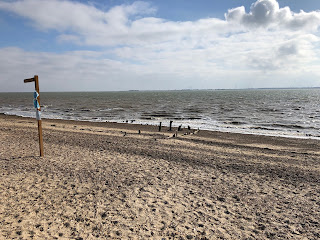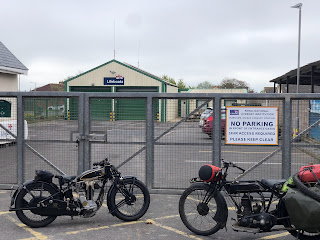The Sunbeam
 |
| The bike, as it was put back together. |
My Cornish Great Grandfather, George Fox, was a shipping agent in Falmouth. His
commute to work was about 5 miles. And depending upon his mood and the Cornish
weather he either drove a car, cycled, or rode his 1926 Model 1 Sunbeam. The bike
was bought secondhand in the 30’s and used up into the 50’s at which point it was left
in the beautiful granite barn next to his house. At some point it was disassembled with
the intention of carrying out a full restoration. This never happened and the Sunbeam
slumbered on in its stable.
 |
| The Sunbeam parts laid out on a door. |
In 2017 Uncle James generously offered the bike to my Dad. In due course it arrived
at our house in Hertfordshire. We laid all the parts out on an old door and tried to
work out what was missing. As far as we could see nothing was. There was even a
pair of hard to find Dunlop 26 x 2 ½ beaded edge tyres. Nowadays original patina is
far more valued than it was 40 years ago. So we decided to clean everything up and
put it back together rather than go for the full restoration.
The re-assembly of the bike proved to be remarkably straightforward. We started by
sending the brake shoes to be relined by Martyn Bratby and the carburettor which had
a very worn slide to Joe the carb. The control cables were all in an advanced state of
decrepitude so we sent the lot to JJ cables who replicated them all. Finally we sent the
magneto to Armoto.
Once the brake shoes were back we spent a happy afternoon in the shed. We began by
cleaning and greasing the cup and cone wheel bearings and the headraces. The girder
fork spindles and bushes were fine and just needed greasing. After a couple of hours
the tyres were on the rims with new tubes, the brakes re assembled with new shoes,
and the forks were re attached to the frame. After bolting on the mudguards and rack
we installed the wheels and handlebars and had a steerable rolling chassis.
 |
| Completed rolling chassis. |
Meanwhile the engine was in the classic barn find condition of a set of cases with the
rod and piston sticking out. The barrel was in another box. Examination revealed
worn valves and guides and a broken exhaust port. James said he had been unable to
unscrew the exhaust nut so he had unbolted the barrel and taken it, exhaust pipe still
attached, to see an Uncle from the other side of the family, Maurice Brierley.
Maurice had an engineering background that included working with DeHavilands in
Hatfield and AMC in Woolwich. DeHavilands in the 1940’s had traffic lights that
enabled workers direct access to the A1. Riding his sidecar outfit Maurice lost his
right leg when a car ran the lights. Unable to continue racing his AJS 7R he took up
sprinting with a supercharged Vincent outfit known as Methamon. The platform
sidecar was unusually mounted on the right hand side on account of his false leg. He
was extremely successful and at one point held the flying kilometre record at 222kph.
When he retired from sprinting he displayed the Vincent in the Shuttleworth
Collection. Around 1979 Shuttleworth short of space asked him to remove it.
Unsure what to do with it Maurice ended up donating Methamon to the VMCC and it
went on display at their Stamford Hall collection.
When Stamford Hall was dispersed Methamon disappeared. By now it had ceased to
be an interesting old motorbike and had become an asset of some value.
All sorts of dark and libellous rumours swirled around regarding its fate. In the end
they proved baseless and the Vincent re surfaced in a basement at Donnington Park. It
remains in the hands of the VMCC and has been painstakingly rebuilt by Chris Ilman.
Currently in rude and noisy health Methamon is regularly displayed and ridden at
VMCC events.
 |
| Barrel with damaged exhaust port. |
Maurice examined the barrel, heated up the nut, and whacked it with a hammer and
drift. The port promptly shattered. Maurice declared the barrel scrap and advised
looking for a new one. The barrel lay undisturbed in its box for the next 40 years.
After several false starts Dad managed to persuade Rick Parkington to repair the
broken port. Given that it was in 3 small pieces he made a very neat job of welding it
all back together and cutting a new thread. He also replaced the valves with Ford
items from a diesel Transit. These had slightly thicker stems. This enabled Rick to
ream out the worn guides to the new stem size. The piston was a bit baggy but
useable. The rings however were worn out. Bantam John supplied a new set that
measured up perfectly. With a useable Top end It was time for the crank. The cases
were easily split but were full of black gunge. Once everything had been cleaned up
the assembly, apart from the main bearings, proved to be in useable condition. The
big end was fine and there appeared to be little wear on the cams or followers. We
sourced 3 new MC22 main bearings ( one on the timing side and 2 on the drive side )
and rebuilt the engine in about 40 minutes. The gearbox just needed a cleanout and re
filling with liquid grease. The engine and gearbox were quickly installed in the frame
and the kickstart, primary drive and rear chain and its chain-case attached.
Everything went back together with remarkable smoothness. It was not the traditional
2 steps forward and 1 step back ( with added unforeseen expense ) rebuild
experience. In amongst the boxes of parts were small envelopes containing nuts and
washers. Given the simplicity of the bike it did not take very long to work out where
they all went. Larger items such as the crankshaft shock absorber were in a selection
of coffee tins. All threads were in good condition and there were no rounded nuts and
bolts. James said that the bike had been looked after by the local garage in
Constantine. They had obviously done fine job of keeping the bike serviceable for the
20 years that Grandfather used it. And the Sunbeam had clearly given unexciting but
reliable and economic service in its role as a commuter.
 |
| As the bike is today, (with happy pilot) |




Comments
Post a Comment